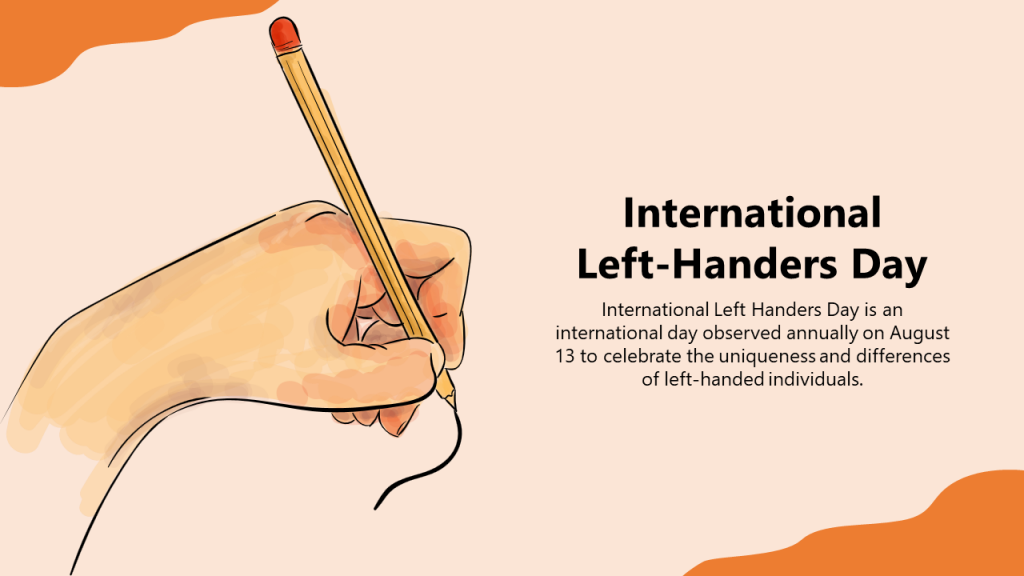International Lefthanders Day
“Left se mat khao!” (“Don’t eat with your left hand!”)
“Left se mat likho!” (“Don’t write with your left hand!”)
Many of us have been subjected to these reprimands as kids. Some of us have grown to be left-handed despite the reprimands.
In a predominantly right-handed world, as per several reports, approximately 10% of the world’s population is known to be left-handed. To celebrate this unique ability of humanity every year August 13 is celebrated as International Lefthanders Day. On this day, awareness is raised for the minority of children who are left-handed and their special needs. Just like the two sides of a coin, being a left-handed person comes with advantages and disadvantages of its own. This day is dedicated to acknowledging the challenges and triumphs of those who prefer their left hand for tasks ranging from writing to sports. As we embrace diversity and inclusivity, Lefthanders Day serves as a reminder that our differences should be celebrated and cherished.
Sunday POST had a chat with a couple of lefties and a neurosurgeon on the misconceptions surrounding lefties and the importance of fostering an environment that supports their needs and preferences.
Left-handed Sarthak Samal, a B.Tech undergrad from Indira Gandhi Institute of Technology Sarang, says, “Our uniqueness is like a badge setting us apart, more so, when we go against the grain in a right-handed world. Whether it’s writing, eating, or other actions, the reactions we elicit are often memorable, especially in new environments.”
Sarthak shares that navigating life as a lefty has its challenges.
“Many skills and norms are designed for the right-handed majority, sometimes leading us to overlook alternative approaches. Even everyday tasks like writing and eating initially involved our left hand. Adapting to societal norms, like using the right hand in formal situations, is a peculiar journey. Nonetheless, our left-handed experiences often align with those of right-handed peers in terms of comfort and effort,” he adds.
Sharing his experience, Sarthak continues: “My personal journey as a left-hander has been relatively smooth, though some issues have surfaced. Left-handed individuals are sometimes associated with unique talents, a notion I embrace. Embracing this aspect of myself, I’m grateful for my left-handedness, leveraging strengths and acknowledging weaknesses in a right-hand-dominated society.”
He signs off by saying, “Understanding the challenges left-handers face and making minor accommodations can bring significant comfort. I believe in the power of listening and adapting, whether it’s allowing a left-handed person to use their preferred hand or recognising their distinct qualities. The successes of prominent left-handed figures, from politicians to celebrities, are inspiring.”
Alisha Pattojoshi, another lefthander who is pursuing her BBA from DSBM, expresses, “I’ve been a lefty since I was a child. My family was startled to see me holding a chalk in my left hand and writing during ‘khadi chhuan’. I am not disheartened; rather, I am glad and proud to be a lefty, as only 10% to 20% of the world’s population is lefty. It’s said that left-handed people have a faster link between both hemispheres of the brain, which leads to faster information processing. I believe that a lefty’s functioning system is identical to that of a righty.”
Explaining the issues faced by most of the lefties, Alisha adds, “I instinctively extend my left hand to receive ‘prasad’ or money, at events such as religious rituals or other occasions. People occasionally express their annoyance with my involuntary use of my left hand. However, I am fortunate to have the support of my family and friends in such situations. They never mock me; instead, they encourage me to teach them left-handed writing, which I gladly do.”
She concludes by saying, “Misconceptions about left-handed individuals persist in our society, often leading to the underestimation of their unique experiences. Lefties have long navigated a world designed predominantly for right-handed people, facing challenges from smudged ink to awkwardly arranged tools. It’s crucial to debunk these misconceptions and create an inclusive environment that acknowledges and caters to their needs.”
Debunking myths associated with left-handed individuals, Dr Rajalaxmi Satapathy, Associate Professor of Neurology at KIIT University, shares, “The human brain has always fascinated us, yet many of its mysteries still remain elusive. It’s unknown why 10–12% of the population turns out to be left handed. This develops at around 18 months of age and is mostly influenced by genetic and environmental factors. Throughout history, left handed people have been considered as negative, evil or unlucky without an iota of scientific evidence. One should not force a child to use the right hand, if the child prefers to use the left hand. There is no observed link between being left-handed and a higher occurrence of cerebral vascular events such as strokes. Moreover, certain studies indicate that left-handed individuals might experience quicker recovery from strokes or injuries.”
Asked if the lefthanders face any health issues for such a habit, she says, “They don’t suffer from any major complications as such. Left-handed people might have a higher prevalence of mood and attention deficit hyperkinetic disorders. On the contrary, despite the prevailing cultural bias towards tools and equipment designed for right-handed individuals, left-handed people tend to display strong creativity and excel in intricate logical thinking.”
Many prominent figures, including Nobel Prize laureates, authors, artists, actors, musicians, and mathematicians, have been known to be left-handed, ends Sathpathy.
MADHUSMITA SAHU, OP

